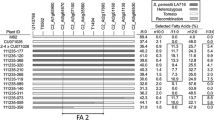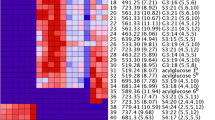Abstract
The tomato breeding line, CU071026, was bred to accumulate high levels of the insect control compounds called acylsugars, which are exuded from glandular trichomes. The acylsugars of CU071026 exhibit a characteristic profile of acylsugar composition and constituent fatty acid acyl groups that is distinct from that of the progenitor wild tomato, Solanum pennellii LA716. A prior study reported the transfer of three QTL (FA2, FA7, and FA8), from S. pennellii LA716, that are associated with changes in acylsugar chemistry into CU071026 and demonstrated that the resulting lines, each of which possesses one of these QTL, displayed a unique acylsugar and fatty acid profile distinct from that characteristic of the acylsugars of CU071026 and each other. The current study utilized marker-assisted backcrossing to combine pairs of two of these QTL or all three of these QTL. This created a new set of lines, which allowed evaluation of the combinatory effects of FA2QTL, FA7QTL, and FA8QTL, on acylsugar level and acylsugar and fatty acid profile and diversity. Analysis of the new tomato lines revealed that these QTL interacted additively and epistatically to alter acylsugar level and chemistry, increasing the diversity of fatty acid constituents and/or acylsugar chemotypes present in the exudates of some of the lines. Extensive characterization of the lines for acylsugar level, through a spectrophotometric invertase assay, and acylsugar chemistry, through gas and liquid chromatography-mass spectrometry, allowed association of the QTL interactions with aspects of acylsugar chemotype. The evaluated fatty acids and acylsugars accumulated by the set of lines generally displayed high heritability and minimal environmental effect, which is discussed. The QTL interactions that govern a more diverse acylsugar and fatty acid profile provide valuable information for the generation of tomato lines with improved acylsugar efficacy against pests of tomato.



Similar content being viewed by others
Abbreviations
- ai-C5:
-
2-Methylbutanoate (anteiso-branched 5-carbon acyl group)
- i-C4:
-
2-Methylpropanoate (iso-branched 4-carbon acyl group)
- i-C5:
-
3-Methylbutanoate (iso-branched 5-carbon acyl group)
- i-C9:
-
Likely 7-methyloctanoate (iso-branched 9-carbon acyl group)
- i-C10:
-
8-Methylnonanoate (iso-branched 10-carbon acyl group)
- i-C11:
-
9-Methyldecanoate (iso-branched 11-carbon acyl group)
- i-C12:
-
Likely 10-methylundecanoate (iso-branched 12-carbon acyl group)
- i-C13:
-
Likely 11-methyldodecanoate (iso-branched 13-carbon acyl group)
- i-C14:
-
Likely 12-methyltridecanoate (iso-branched 14-carbon acyl group)
- n-C10:
-
n-Decanoate (straight chain 10-carbon acyl group)
- n-C12:
-
n-Dodecanoate (straight chain 12-carbon acyl group)
References
Akhtar Y, Isman MB (2003) Binary mixtures of feeding deterrents mitigate the decrease in feeding deterrent response to antifeedants following prolonged exposure in the cabbage looper, Trichoplusia ni (Lepidoptera: Noctuidae). Chemoecology 13:177–182. doi:10.1007/s00049-003-0246-0
Bates D, Maechler M, Bolker B, Walker S (2014) Linear mixed-effects models using Eigen and S4. R package version 1.1-4. http://CRAN.R-project.org/package=lme4. Accessed 15 Sept 2016
Becerra JX, Noge K, Venable DL (2009) Macroevolutionary chemical escalation in an ancient plant–herbivore arms race. PNAS 106:18062–18066. doi:10.1073/pnas.0904456106
Blauth SL, Churchill GA, Mutschler MA (1998) Identification of quantitative trait loci associated with acylsugar accumulation using intraspecific populations of the wild tomato, Lycopersicon pennellii. Theor Appl Genet 96:458–467. doi:10.1007/s001220050762
Blauth SL, Steffens JC, Churchill GA, Mutschler MA (1999) QTL analysis of acylsugar fatty acid constitutents using intraspecific populations of the wild tomato Lycopersicon pennellii. Theor Appl Genet 99:373–381. doi:10.1007/s001220051247
Burke B, Goldsby G, Mudd JB (1987) Polar epicuticular lipids of Lycopersicon pennellii. Phytochemistry 26:2567–2571. doi:10.1016/S0031-9422(00)83879-0
Cacho NI, Kliebenstein DJ, Strauss SY (2015) Macroevolutionary patterns of glucosinolate defense and tests of defense-escalation and resource availability hypotheses. New Phytol 208:915–927. doi:10.1111/nph.13561
Castellanos I, Espinosa-García FJ (1997) Plant secondary metabolite diversity as a resistance trait against insects: a test with Sitophilus granarius (Coleoptera: Curculionidae) and seed secondary metabolites. Biochem Syst Ecol 31:591–602. doi:10.1016/S0305-1978(97)00045-8
Duffey SS, Stout MJ (1996) Antinutritive and toxic components of plant defense against insects. Arch Insect Biochem Physiol 32:3–7. doi:10.1002/(SICI)1520-6327(1996)32:1<3::AID-ARCH2>3.0.CO;2-1
Eshed Y, Zamir D (1994) A genomic library of Lycopersicon pennellii in L. esculentum: a tool for fine mapping of genes. Euphytica 79:175–179. doi:10.1007/BF00022516
Eshed Y, Zamir D (1995) An introgression line population of Lycopersicon pennellii in the cultivated tomato enables the identification and fine mapping of yield-associated QTL. Genetics 141:1147–1162
Fan P, Last RL et al (2016) In vitro reconstruction and analysis of evolutionary variation of the tomato acylsucrose metabolic network. Proc Natl Acad Sci 113:E239–E248. doi:10.1073/pnas.1517930113
Fancelli M, Vendramim JD, Frighetto RTS, Lourencao AL (2005) Glandular exudate of tomato genotypes and development of B. tabaci (Genn.) (Sternorryncha: Aleyrodidae) biotype B. Neotrop Entomol 34:659–665. doi:10.1590/S1519-566X2005000400017
Fobes JF, Mudd J, Marsden M (1985) Epicuticular lipid on the leaves of L. pennellii and L. esculentum. Plant Physiol 77:567–570. doi:10.1007/s11032-013-9849-5
Ghosh B, Westbrook TC, Jones AD (2014) Comparative structural profiling of trichome specialized metabolites in tomato (Solanum lycopersicum) and S. habrochaites: acylsugar profiles revealed by UHPLC/MS and NMR. Metabolomics 10:496–507. doi:10.1007/s11306-013-0585-y
Goffreda JC, Mutschler MA (1989) Inheritance of potato aphid resistance in hybrids between Lycopersicon esculentum and L. pennellii. Theor Appl Genet 78:210–216. doi:10.1007/BF00288801
Goffreda JC, Mutschler MA, Steffens JC (1990) Association of epicuticular sugars with aphid resistance in hybrids with wild tomato. J Am Soc Hortic Sci 117:161–164
Hawthorne DM, Shapiro JA, Tingey WM, Mutschler MA (1992) Trichome-borne and artificially applied acylsugars of wild tomato deter feeding and oviposition of the leaf-miner, Liriomyza trifolii. Entomol Exp Appl 65:65–73. doi:10.1111/j.1570-7458.1992.tb01628.x
Holland JB, Nyquist WE, Cervantes-Martínez CT (2003) Estimating and interpreting heritability for plant breeding: an update. Plant Breed Rev 22:9–112
Juvik J, Shapiro JA, Young TE, Mutschler MA (1994) Acyl-glucoses of the wild tomato Lycopersicon pennellii alter behavior and reduce growth and survival of Helicoverpa zea and Spodoptera exigua. J Econ Entomol 87:482–492. doi:10.1007/s11032-013-9849-5
Kim J, Kang K, Gonzales-Vigil E, Shi F, Jones D, Barry CS, Last RL (2012) Striking natural diversity in glandular trichome acylsugar composition is shaped by variation at the acyltransferase2 locus in the wild tomato Solanum habrochaites. Plant Physiol 160:1854–1870. doi:10.1104/pp.112.204735
King RR, Pelletier Y, Singh RP, Calhoun LA (1986) 3,4-Di-O-isobutyryl-6-O-caprylsucrose: the major component of a novel sucrose ester complex from the type B glandular trichomes of Solanum berthaultii hawkes (Pl 473340). J Chem Soc Chem Comm 14:1078–1079. doi:10.1039/C39860001078
King RR, Calhoun LA, Singh RP (1988) 3,4-Di-O- and 2,3,4-tri-O-acylated glucose esters from the glandular trichomes of nontuberous Solanum species. Phytochemistry 27:3765–3768. doi:10.1016/0031-9422(88)83014-0
Leckie BM, DeJong DM, Mutschler MA (2012) Quantitative trait loci increasing acylsugars in tomato breeding lines and their impacts on silverleaf whiteflies. Mol Breed 31:957–970. doi:10.1007/s11032-012-9746-3
Leckie BM, DeJong DM, Mutschler MA (2013) Quantitative trait loci regulating sugar moiety of acylsugars in tomato. Mol Breed 31:957–970. doi:10.1007/s11032-013-9849-5
Leckie BM, Halitschke R, De Jong DM, Smeda JR, Kessler A, Mutschler MA (2014) Quantitative trait loci regulating the fatty acid profile of acylsugars in tomato. Mol Breed 34:1201–1213. doi:10.1007/s11032-013-9849-5
Leckie BM, Mutschler MA et al (2016) Differential and synergistic functionality of acylsugars in suppressing oviposition by insect herbivores. PLoS One 11:1–19. doi:10.1371/journal.pone.0153345
Liedl BE, Lawson DM, White KK, Shapiro JA, Cohen DE, Carson WG, Trumble JT, Mutschler MA (1995) Acylglucoses of the wild tomato Lycopersicon pennellii alters settling and reduces oviposition of Bemisia argentifolii. J Econ Entomol 88:742–748. doi:10.1093/jee/88.3.742
Mutschler MA, Wintermantel WM (2006) Reducing virus associated crop loss through resistance to insect vectors. In: Loebenstein G, Carr JP (eds) Natural resistance mechanisms of plants to viruses. Springer, Dordrecht, pp 241–260
Ning J, Last RL et al (2015) A feedback insensitive isopropylmalate synthase affects acylsugar composition in cultivated and wild tomato. Plant Physiol 169:1821–1835. doi:10.1104/pp.15.00474
Oksanen J et al. (2013) Vegan: community ecology package. R package version 2.0-7
Reich M, Liefeld T, Gould J, Lerner J, Tamayo P, Mesirov JP (2006) GenePattern 2.0. Nat Genet 38:500–501
Rodriguez AE, Tingey WM, Mutschler MA (1993) Acylsugars produced by type IV trichomes of Lycopersicon pennellii (Corr.) D’Arcy deter settling of the green peach aphid, Myzus persicae (Sulzer) (Homoptera: Aphididae). J Econ Entomol 86:34–39. doi:10.1093/jee/86.1.34
SAS Institute Inc (2015) JMP® 12 JSL syntax reference. SAS Institute Inc, Cary
Schilmiller AL, Shi F, Kim J, Charbonneau A, Holmes D, Jones AD, Last RL (2010) Mass spectrometry screening reveals widespread diversity in trichome specialized metabolites of tomato chromosomal substitution lines. Plant J 62:391–403
Schilmiller AL, Charbonneau AL, Last RL (2012) Identification of a BAHD acetyltransferase that produces protective acyl sugars in tomato trichomes. Proc Natl Acad Sci U S A 109:16377–16382. doi:10.1073/pnas.1207906109
Schilmiller AL, Moghe GD, Fan P, Ghosh B, Ning J, Jones AD, Last RL (2015) Functionally divergent alleles and duplicated loci encoding an acyltransferase contribute to acylsugar metabolite diversity in Solanum trichomes. Plant Cell 27:1002–1017. doi:10.1105/tpc.15.00087
Schilmiller AL, Gilgallon K, Ghosh B, Jones AD, Last RL (2016) Acylsugar acylhydrolases: carboxylesterase catalyzed hydrolysis of acylsugars in tomato trichomes. Plant Physiol 170:1331–1344. doi:10.1104/pp.15.01348
Severson RF, Johnson AW, Jackson DM (1985) Cuticular constituents of tobacco: factors affecting their production and their role in insect and disease resistance and smoke quality. Recent Adv Tobacco Sci 11:105–174
Shannon ER, Weiner W (1963) The mathematical theory of communication. The University of Illinois Press, Urbana, p 117
Shapiro J, Steffens J, Mutschler MA (1994) Acylsugars of the wild tomato Lycopersicon pennellii in relation to its geo-graphic distribution. Biochem Syst Ecol 22:545–561. doi:10.1016/0305-1978(94)90067-1
Slocombe SP, Schauvinhold I, McQuinn RP, Besser K, Welsby NA, Harper A, Aziz N, Li Y, Larson TR, Giovannoni J, Dixon RA, Broun P (2008) Transcriptomic and reverse genetic analyses of branched-chain fatty acid and acyl sugar production in Solanum pennellii and Nicotiana benthamiana. Plant Physiol 148:1830–1846. doi:10.1104/pp.108.129510
Smeda JR, Schilmiller AL, Last RL, Mutschler MA (2016) Introgression of acylsugar chemistry QTL modifies the composition and structure of acylsugars produced by high-accumulating tomato lines. Mol Breed 36:160. doi:10.1007/s11032-016-0584-6
Walters DS, Steffens JC (1990) Branched-chain amino acid metabolism in the biosynthesis of Lycoperiscon pennellii glucose esters. Plant Physiol 93:1544–1551. doi:10.1104/pp.93.4.1544
Acknowledgements
We thank Jennifer Thaler for valuable discussions on the implications of metabolite diversity as it relates to acylsugar-mediated insect control and critical reading of the manuscript. This project was supported in part by Agriculture and Food Research Initiative Competitive Grant no. 2013-67013-21135 from the USDA National Institute of Food and Agriculture and by the USDA National Institute of Food and Agriculture, Hatch project NYC-149440 (to M.A.M). Smeda was supported in part by an NSF GRFP graduate fellowship, as well as for one semester by Agriculture and Food Research Initiative Competitive Grant no. 2010-85117-20551.
Author information
Authors and Affiliations
Corresponding author
Ethics declarations
Conflict of interest
The authors declare that they have no conflict of interest.
Rights and permissions
About this article
Cite this article
Smeda, J.R., Schilmiller, A.L., Kessler, A. et al. Combination of QTL affecting acylsugar chemistry reveals additive and epistatic genetic interactions to increase acylsugar profile diversity. Mol Breeding 37, 104 (2017). https://doi.org/10.1007/s11032-017-0690-0
Received:
Accepted:
Published:
DOI: https://doi.org/10.1007/s11032-017-0690-0




